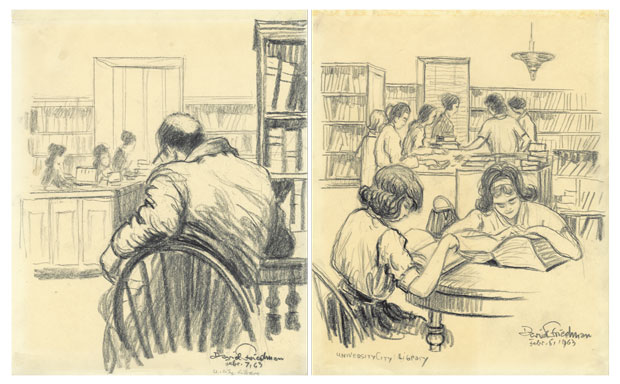Artist’s sketches capture life in St. Louis libraries
Published June 25, 2014
You might not think of the library as a place that fosters creativity and serenity at the same time, but artist and Holocaust survivor David Friedman reaped these benefits from several St. Louis libraries.
The exhibition “Enjoyment in Libraries With the Candid Pencil of David Friedman” is on view in Washington University’s Olin Library through July. A portraitist, printmaker and billboard artist, Friedman (1893-1980) lost his wife and daughter in the Holocaust. After the war ended, he met and married Hildegard, also a survivor, and the couple moved to the United States. They settled in St. Louis and raised their daughter Miriam.
After Friedman retired in 1962, he began a series of Holocaust artworks titled “Because They Were Jews!” and created a series of spontaneous sketches of library patrons. The artist made repeated visits to seven libraries from 1962 to 1967 including Olin, the St. Louis County Library-Clayton branch and the University City Public Library.
“These drawings were an enjoyable subject, ‘studies of life,’ in marked contrast to the tragedy he depicted in his Holocaust work,” Miriam Friedman Morris explains. “He loved the ambience of the library, the quiet concentration of the people and the hushed tones of the spoken word.”
Though these drawings don’t seem to contain any Jewish subject matter, Friedman Morris asserts, “Being Jewish shows in your work even if you don’t depict Jewish subjects. Judaism is part of your life. It’s your identity.”
In 2012 and last year, Friedman Morris donated 88 of these library drawings to the Modern Graphic History Library at Washington University. Library curator Skye Lacerte says, “They are a new acquisition, and this is our first opportunity to show David Friedman’s work. It’s appropriate to have this collection displayed in a library.”
Friedman Morris grew up in St. Louis and now lives in New York. When she visited St. Louis a few years ago, she went to the Art & Architecture Library at the university and gave a librarian a CD of images of her father’s drawings. The CD made its way to Lacerte, who then contacted Friedman Morris about the pieces. Friedman Morris donated the drawings in memory of her parents.
“The drawings belong in St. Louis because they were created there,” she says. “It’s important to have my father’s works in an environment where people can enjoy them.”
Friedman lived in St. Louis longer than anywhere else, and the city was also the last place he lived before his death.
Friedman’s art is exhibited in the Gingko Reading Room and Grand Staircase Lobby on Level 1 of Olin Library. The sketches are divided into themes of “Seeking Assistance,” “Collaborating,” “Writing,” “Reading Books,” “Reading Newspapers,” “Reading Magazines” and “Snoozing.” These themes became evident when Lacerte and her colleagues set out all of the sketches chosen for the exhibition and decided which pieces looked best together.
“I love the ‘Seeking Assistance’ drawings with the information desk and crowds of people,” Lacerte says. “They show how lively libraries can be.”
Of the “Snoozing” drawings, which depict dozing patrons, she says, “They’re kind of funny. Friedman captures everything people do at libraries.”
All of the works reveal glimpses of people at a moment in time. When the subjects moved, the drawing was over.
“My father was having fun with these,” Friedman Morris says. “How fast could he sketch before the person moved?”
As for the quality of the sketches, Lacerte says: “Friedman’s technique and the lines and curves are amazing. I could stare at the pieces all day.”
Each subject’s personality comes out in his or her portrait: Some people sit up straight as they work, while others slouch. The sketches contain implied actions as well: writing, turning pages, shifting in seats.
Some drawings depict not only a moment in time but also an era in time. In a piece titled “Unknown,” a man sits in a Danish modern chair with bookshelves behind him.
“That chair is iconic of Washington University and Olin, and of the era when these drawings were created,” Lacerte says. (All of the pieces were untitled when they came to Washington University; they were given titles in order to distinguish them from one another).
The exhibition also includes black-and-white photographs of the interior of Olin, taken in the 1950s and 1960s. Lacerte selected these to give the show an extra punch. One image depicts a girl sleeping on a couch; a photo of a nun is displayed next to Friedman’s sketch of a nun titled “University City Public Library.” The photographs are almost contemporary with the drawings, and they deal with similar subject matter.
“It was fun trying to think of connections between the photos and drawings,” Lacerte says.
After the exhibition closes, Friedman’s drawings will return to the archives of the Modern Graphic History Library. The archives are open to the public from 9 a.m. to 5 p.m. Monday through Friday.
Friedman Morris is working on a catalog of the complete works of her father. If you own one of his artworks, please contact her at [email protected]. She would like to photograph the piece for her inventory.
















